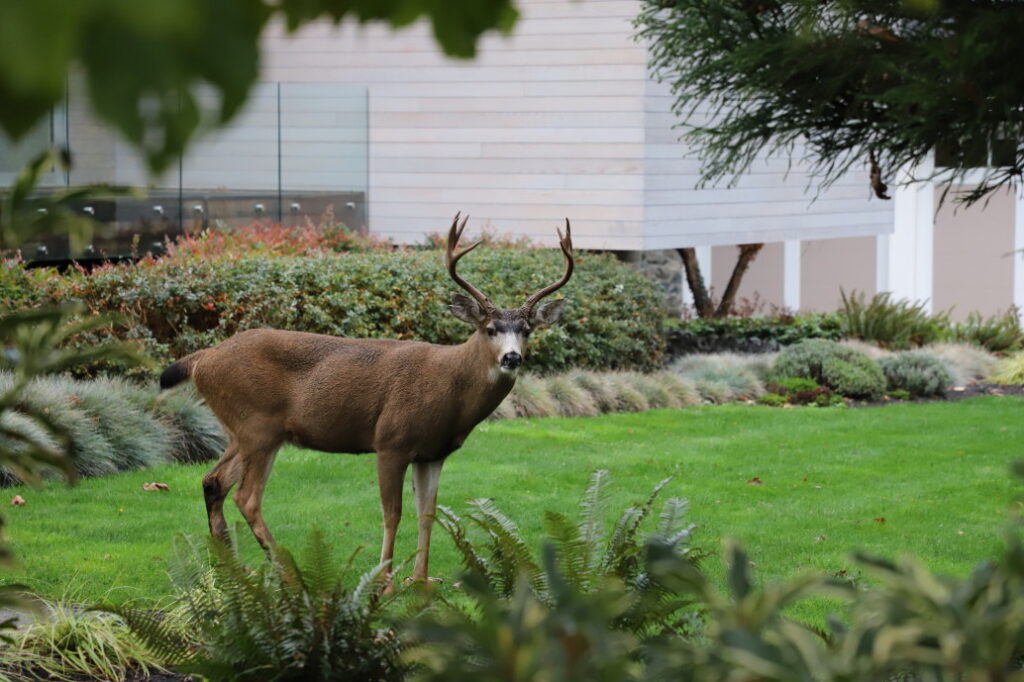 Are Deer A Nuisance To Your Yard?
Are Deer A Nuisance To Your Yard?
Homeowners and gardeners find deer a challenge and see them as a problem when this wildlife invades their property. With less and less of their natural habitat of dense forests, they are forced to look for meals in city yards.
These beautiful creatures are often considered nuisance and destructive animals. This is because they feed on landscape plants and trees, and crops in gardens, which causes a lot of damage, especially if there is a family of deer that found itself in the yard. During the winter months, cold temperatures and deep snow make deer look for food in various places, such as your yard. Also, since deer are animals of habit, they can often return to the same territory. Thus, you should be worried if you see deer in your yard.
In addition, even though deer are usually not aggressive when not provoked or frightened, they can still attack humans when they sense that they or their babies are in danger.
But deer can pose a threat in a different way as they spread disease. There is an indirect risk of attracting deer ticks to your yard, if you happen to see deer a lot. As a result, people can catch Lyme disease from deer ticks.
What Attracts Deer To Your Yard?
If you happen to have a pond, swimming pool, or any kind of water source on your property, deer may stop by and drink the water whenever it is available. In winter, they might eat snow as well or rummage in the snow to expose edible grass to eat.
However, the biggest attraction for deer is the food that is available in your yard. Deer can feed on all sorts of vegetation and crops that are commonly found in yards, ranging from lawn grass, hay, ornamental flowers, tree bark, up to vegetables and fruit.
They are herbivorous animals that spend a lot of their time browsing and foraging. To avoid predators, deer are mainly active at night when searching for food. This is when they will do most of the damage to your property.
You’ll often find deer grazing on grasses, especially if you live in a suburban area. They will eat grass, however, it is not their favorite or nutritionally essential food. They prefer to consume grass that is green, young, and succulent. Many gardeners agree that deer seem to show a preference for plants that have been fertilized. Deer are also known to dig up a lawn in search of grubs, which they like to eat in the fall.
Deer consume mainly weeds, broadleaf plants, leaves, twigs, tips of trees and woody shrubs, and shoots of woody plants or vines. Also, if you have flowers and flowering plants growing in your garden, these will definitely attract deer. They prefer daylilies, English ivy, brambles, fireweed, American mountain ash, dandelion, sweet lupin, hostas, campion, redleg, chicory, hoary cinquefoil, red clover, ribwort plantain, yarrow, and occasionally the thorny canes of rose bushes. Deer will devour on the buds, blooms, and foliage.
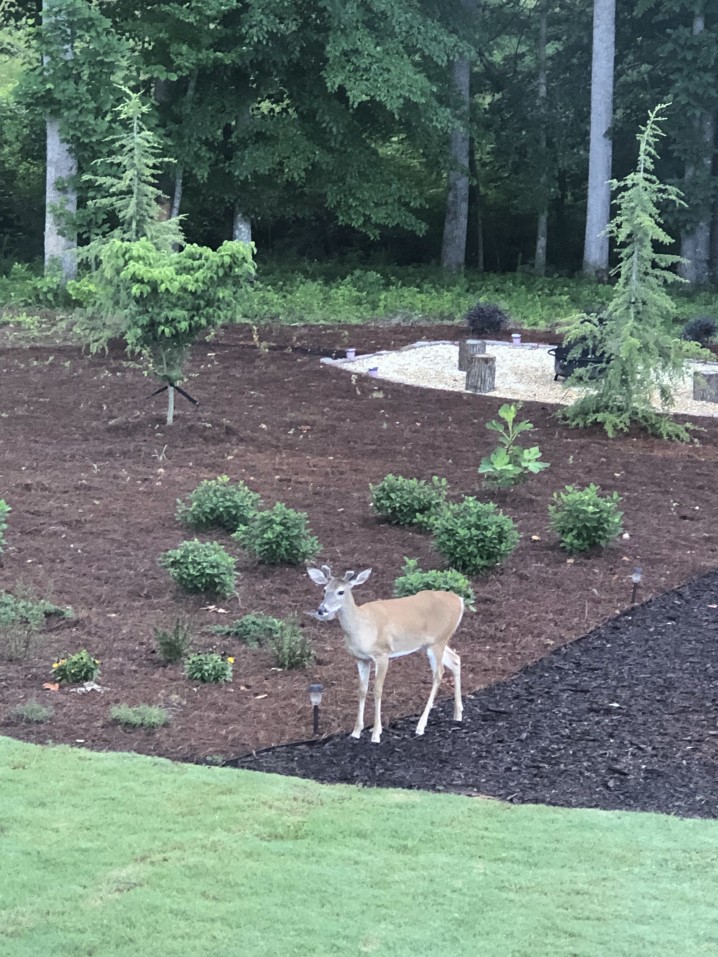
Fruits that are appealing to these animals and satisfy their appetites include apples, strawberries, blackberries, blueberries, and persimmons.
When food is scarce, deer will also not despise many vegetables and will eat just about anything like hot peppers or prickly-stemmed okra. The vegetables that deer choose to consume include certain high-protein crops such as beans, peas, cabbage, broccoli, kale, lettuce, turnips, cauliflower, soybeans, alfalfa, sorghum, corn, and Brussels sprouts. Carrots are among their favorite vegetables, deer will enjoy digging up the carrots and eating them.
Deer are especially fond of the narrow-leaf evergreens, especially fir and arborvitae trees. They love the tender tips of young trees. Also, they like the nutritious nuts that come from pecans, chestnuts, hickory, acorns and beechnut acorns.
Finally, deer cause damage not only through consuming the various plants and crops. Deer will stomp all over the garden and lawn, kick around plants, and compact the soil.
What Damage Do Deer Cause To Trees?
Deer will eat the bark of young trees, as well as any buds, twigs, and acorns they can reach. On many occasions, they also eat the bark off of certain species of trees for nourishment.
Serious damage will be done to established trees when deer browse the buds. The animals nip the tree at the base, creating multiple stemmed trees and causing reduced growth rates.
Besides eating certain parts of the smaller trees and shrubs, the bucks (male deer) can also do serious damage to them by rubbing their antlers up against the trunk and stem of the tree. But this activity happens late at night, mostly from early fall to late winter during the breeding season or rut. The bucks rub against the tree to smooth out their growing antlers, scraping the bark off. This will destroy or even completely kill the trees, especially the young and thin-barked species as well as the newly planted seedlings.
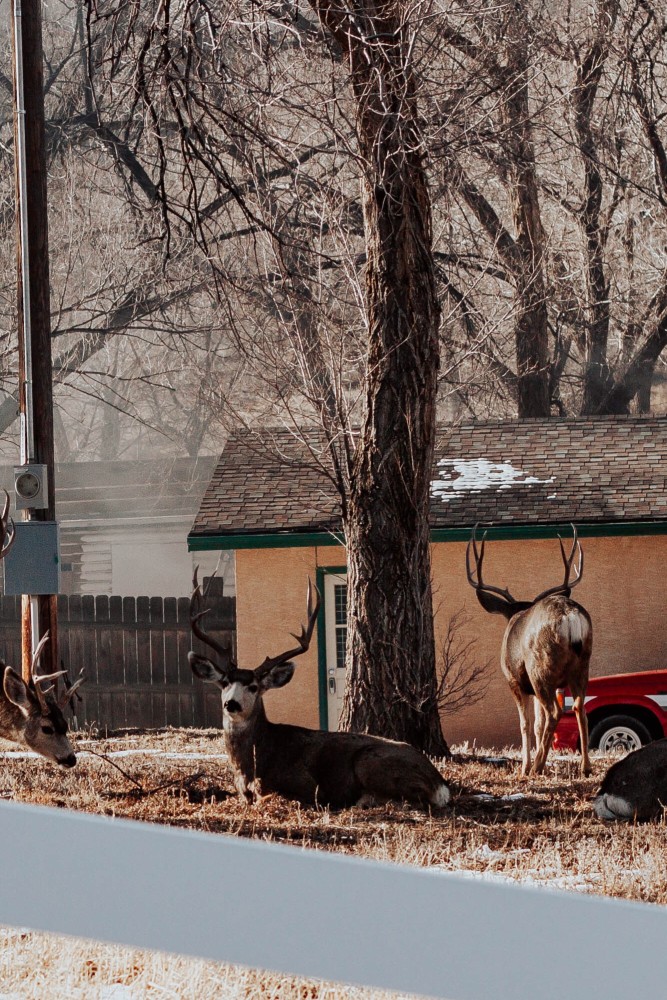
How To Keep Deer Away From Eating Plants And Trees In Your Yard?
As deer can be a real nuisance for gardeners and homeowners, it’s important to keep this wildlife off your property in the first place.
The most effective way to protect trees and garden vegetation from deer is fencing. If there are many trees in your orchard, enclose the whole area using woven-wire fencing. However, to properly deer proof the area, the fence must be a minimum of 6, or even 8 feet high. It also needs to be at an angle of around 30 degrees.
Other methods to keep deer away include mesh netting, choosing deer repellent plants, flowers, and shrubs, as well as using chemical deterrents and scare devices.
If you’re having constant problems with deer and need wildlife removal and control, it’s important to get in touch with a professional as removing deer can be very challenging. Westchester Wildlife company provides humane live and dead deer removal services in Fairfield County CT, or Westchester, Putnam, and Dutchess Counties NY. Call us today for a free phone consultation or appointment.
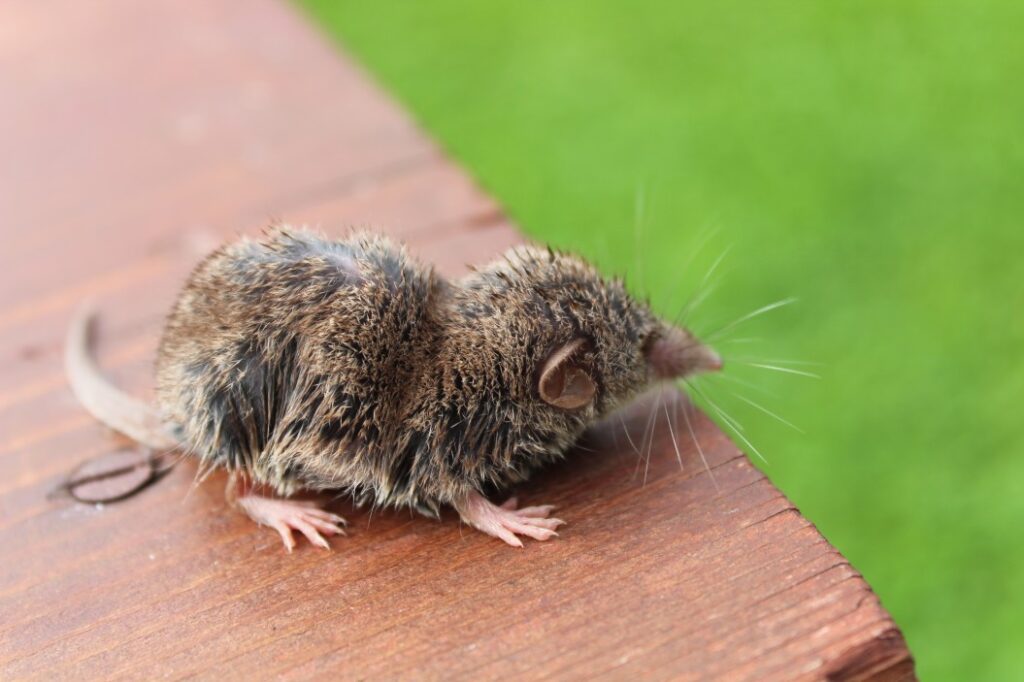 Do Shrews Dig Holes And Live Underground In My Yard?
Do Shrews Dig Holes And Live Underground In My Yard?
The shrew has a long, pointed snout and protruding whiskers. It might look cute but it is a dangerous little animal and an outdoor pest that can be often found digging its way through yards. For its residence, it either builds its burrow from scratch or takes over an abandoned burrow from other rodents like chipmunks or moles.
You might often notice several one-inch-diameter entrance holes are left around the yard by shrews when they dig their underground tunnel systems. In the wild, these holes are most likely found in areas with damp, shaded, overgrown vegetation.
But shrews do not discriminate and they also love to dig holes in gardens and yards. Unfortunately, this causes a lot of damage for homeowners. While these animals are at it, they’ll often uproot entire plants. In addition, their shallow tunnels in lawns can become a safety hazard for people.
Keep reading to learn more about shrews digging and living in your yard.
Do Shrews Dig Tunnels, Burrow, Or Nest Underground?
Shrews are ground animals that live in a great variety of habitats. Most of them prefer locations that are well-covered shelters under the ground so that they can be protected against predators and the harsh winter weather.
The exact habitat depends on the species, but in most cases, shrews make their home in your yard, either underground in abandoned burrows, or by burrowing underneath flat rocks, tree stumps, blocks of pavement, big rotting wood logs, in vegetation like bushes, in tree cavities, and in the crevices of house foundations.
They dig small tunnels that often lead to the entrance opening of the burrow. Because of their location, you can tell them apart from the rest of the holes in the yard. This is also due to the size and angle of the holes, which makes it easier to identify them as the holes dug out by shrews. These mammals can also excavate tiny, dime-sized holes in the lawn in order to gain access to mole tunnels.
Shrews are not as much destructive as moles and voles, thus, many people choose to leave them alone. Foraging for insects, worms, spiders, snails, and grubs in the grass, shrews search for them both above and below the ground.
Unlike other small mammals, shrews do not create surface tunnels. Instead, they prefer to tunnel underground and use the runways and tunnels constructed by larger animals such as voles or moles.
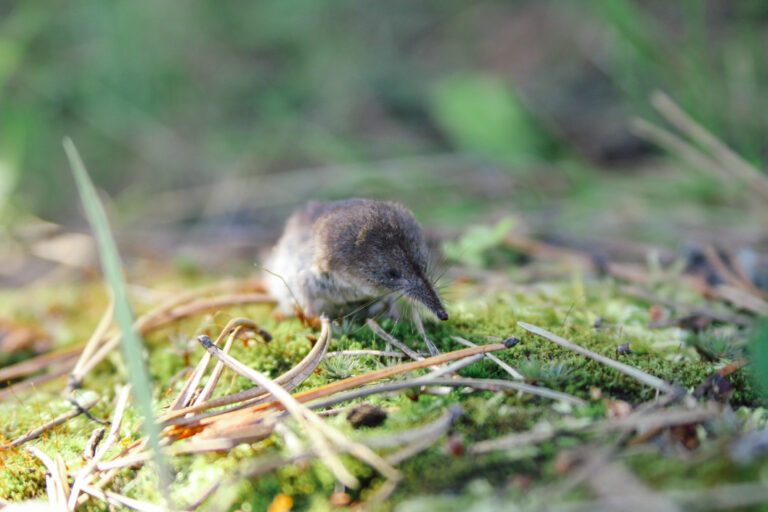
How Deep Can Shrews Dig?
The shrews have strong front feet with 5 clawed toes on each foot, which enables them to dig deep into the ground. They remove the loose soil and dirt from the tunnel with the help of their hind feet by kicking it out, or by pushing it out with their elongated snout.
On average, the burrows are around 4 inches deep below the surface, but in the most extreme cases, as much as 20 inches can be dug into the ground. The burrow is flat inside, both on the bottom and at the top. The nest itself is made inside the burrow and is covered with fur or dense, dry vegetation.
Do Shrews Come Above The Ground?
Similar to mice and rats, shrews are great climbers. They can also jump up for more than 4 inches in the air, which makes them very agile. They need to be constantly on the move, so they come above the ground from time to time, particularly at night, as they are nocturnal animals. You can sometimes notice them running on the ground rapidly with jerky movements.
If not staying in their burrows, shrews can be sometimes found scurrying on the ground, or getting around in runways made in leaves and other surface litter or snow. However, this wildlife spends most of its time underground.
With that said, shrews are not afraid to enter homes searching for food or shelter, even if they prefer to live outdoors.
For the most part, the yard damage caused by shrews consists of underground tunnels and holes they dig in search of food. Shrews are one of the most voracious wildlife that can invade people’s residences, thus, causing a lot of destruction. Having a very high metabolism, they need to feed almost continuously.
Shrews are known for gnawing on tree bark, chewing grass and plant roots in yards. They also contaminate food sources, such as vegetables and fruits in the garden, with their urine and droppings.
Despite that, as they can be easily mistaken for voles, shrews might get all the blame for destroyed yards. But in general, even though they can ruin the look of your lawn with their holes, these mammals are beneficial as they are important members of the ecosystem. They prey on species such as rodents, harmful insects, and other outdoor pests.
However, if the shrews have invaded your property and have become a nuisance, they may need to be eliminated. Call Westchester Wildlife for advice or schedule an appointment with one of our experienced and knowledgeable pest and wildlife professionals.
All in all, the best way to get rid of shrews in the yard is through trapping. But these animals run fast and can easily escape without being caught. If you need help trapping and removing a shrew from your home or yard, get in touch with our team in Westchester, Dutchess, Putnam Counties in NY, or Fairfield County in CT. We will be happy to assist you!
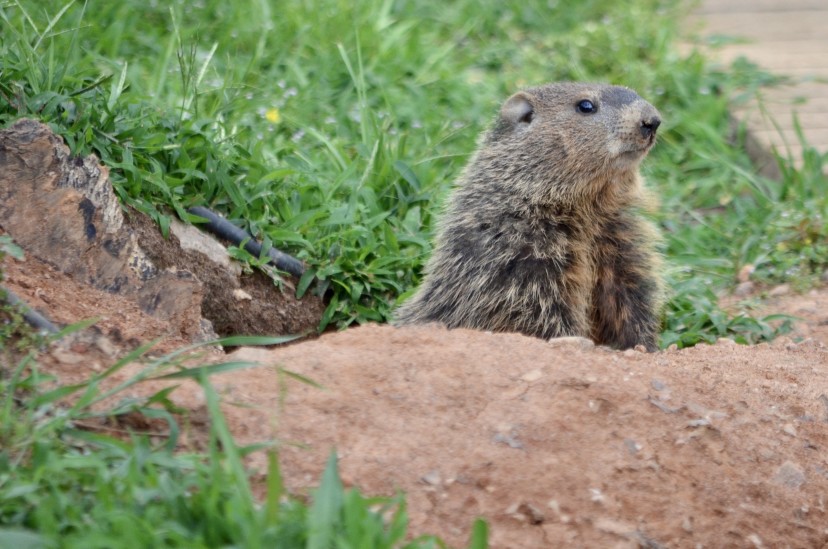 Do Groundhogs Hibernate In Winter?
Do Groundhogs Hibernate In Winter?
You must have heard about the groundhog tradition that originated in Pennsylvania. It suggests that if the groundhog sees its shadow, it will return to its den and you can expect another 6 weeks of winter. However, if the animal does not see its shadow, then spring is just around the corner!
A groundhog is not just like any other wild animal that you see in the woods or might take up residence on your property. It has some fascinating behavior that sets it apart from most wildlife.
According to scientists, the groundhog, also known as the woodchuck, is considered to be a deep hibernator in the wintertime. What it means is that they spend the whole winter in a state of hibernation.
Hibernation is a form of unconscious sleep and a state of lowered metabolism and suppressed appetite which causes the animal not to eat. As the animal does not feel hunger or stress, it can save energy and conserve nutrients for later use. Hibernation helps the animal to survive in the harsh winters when food is scarce.
In fact, the groundhog spends a large portion of the summer and fall season chowing down on the foods that they eat. And, once it builds up all of the fat that it needs on its body, it is ready to get inside its burrow for the hibernation period.
If you want to learn more about some of the unique habits of groundhogs, keep reading!
Why Do Groundhogs Hibernate And How Do They Prepare For Hibernation?
There may be different reasons why some animals hibernate during the winter months.
One of the most common reasons for the groundhog’s hibernation is its dietary needs, especially when food is scarce. Groundhogs have a difficult time finding food sources during the winter season because of the scarcity of the foods that they consume.
Thus, nature causes the groundhogs to go into a deep hibernation state for their survival. This is also why they eat constantly during the off-season (i.e. the summer months) to prepare their body for these long and cold winter months.
The groundhog’s appetite hormones regulate metabolism during the hibernation period and help the body conserve its energy.
As groundhogs burrow in the ground, before going into their winter sleep, they dig a den that comfortably accommodates them. The groundhog sleeps for between 5 and 7 months, but typically, this hibernation period lasts from October to March.
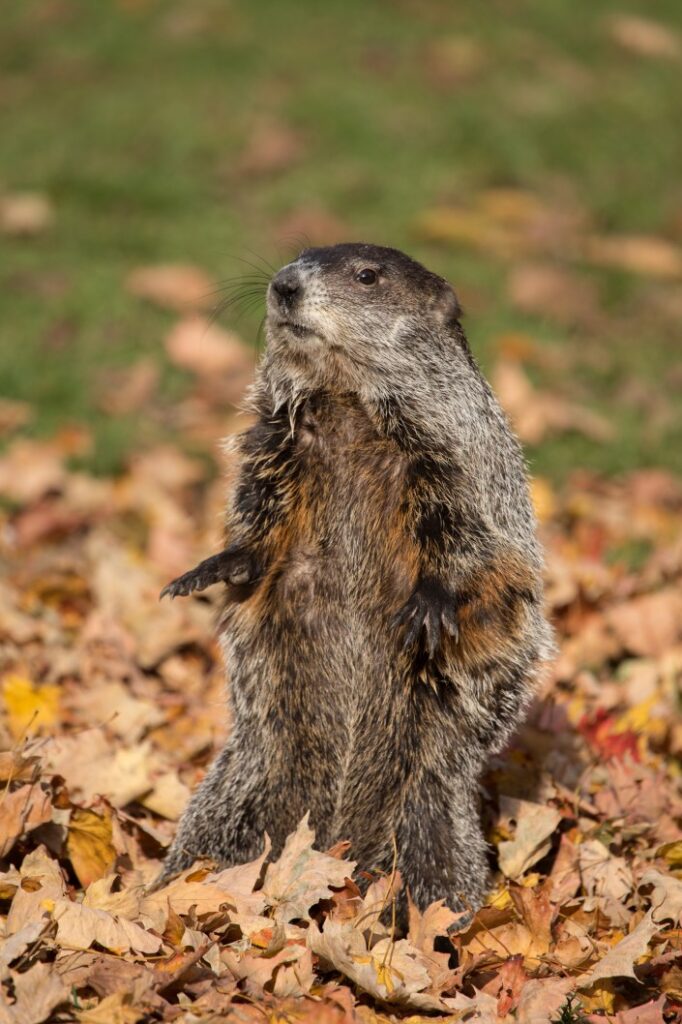
What Happens When Groundhogs Hibernate?
The groundhog’s body lowers all movements and functions to ensure that the animal can survive while sleeping through the winter.
According to the National Wildlife Federation, the temperature of the groundhog’s body will decrease significantly. It will drop from 99° F to about 37° F. This rodent stays warm by conserving body heat, which can help maintain the core body temperature at a stable level.
In addition, there are also other changes that occur in their body when the groundhogs are inactive during the hibernation period. For instance, their heart rate reduces and their breathing will slow down as well. Thus, the rate of their breathing will drop from around 16 breaths to just 2 breaths per minute. Their normal heart rate of about 80 to 100 beats per minute during the pre-hibernation period will reduce to just 4 or 5 beats per minute.
These are the primary reasons why these animals are referred to as deep hibernators.
Where Do Groundhogs Hibernate?
These rodents are solitary creatures and tend to hibernate alone. As mentioned earlier, groundhogs hibernate in underground burrows that they dig using their powerful claws and teeth.
The hole is a circular area covered with leaves, grasses, sticks, and branches. To keep itself warm inside the hole, the animal covers the den with piles of dirt that serve as insulation from the cold.
Do Groundhogs Eat During Hibernation?
Groundhogs don’t wake up to eat during their hibernation period. They are herbivores, which means they only feed on vegetation, and that is not readily available in winter. When in their natural habitat, these animals could therefore be driven into starvation due to the lack of food in the freezing weather. But groundhogs must survive without eating for months at a stretch and avoid starvation.
Thus, they are highly adapted to survive even when such food is scarce in the wintertime. Groundhogs hibernate to conserve energy and prevent hunger. They are able to survive on stored fat and use it to produce energy during hibernation.
They get energy when fat in their body is used. Also, their body has reduced their nutrition needs, allowing the groundhog to survive for a few months without eating.
Do you need groundhog removal services in Fairfield County CT, or Westchester, Putnam, and Dutchess Counties NY? Our professionals at Westchester Wildlife can humanely and safely trap and remove groundhogs that live on your property. So contact us today for a free phone consultation or an appointment.
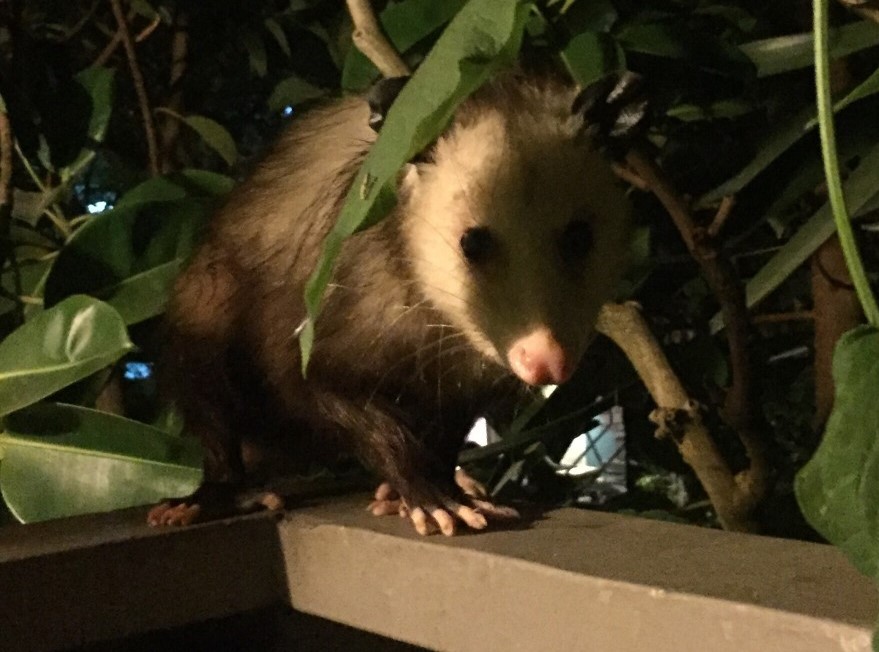 Can Opossums Climb And Get In Your Walls?
Can Opossums Climb And Get In Your Walls?
If you are like most homeowners, you do not like wildlife taking up residence in your house. Perhaps you are wondering whether opossums can climb and get in your walls. If you do not take precautions, the answer is “Yes!”
How High Can Opossums Climb?
Opossums are incredibly agile, they can easily climb a tall vertical wall. They are known to jump from a tree to a roof at a distance of up to 13 feet. This wildlife can use its thumbs, feet, claws, and tails to climb many different surfaces.
When it comes to how high they can actually climb, it is difficult to determine. It all depends on what they can grab onto, and the surface itself.
While an opossum can climb up a vertical wall, it is easier for one to navigate horizontal surfaces. The animal can do even more climbing if there is a tree near your house, or if you have gutters, eaves, or shingles on your house. As they can climb very high, you may find possums are living in your attic.
Can Opossums Live In Your Walls?
Possums prefer attics, porches, or sheds to make a nest, but they can live in your walls, too. Occasionally, they might end up inside walls because they get stuck or just feel comfortable in there. Similar to other pests, this is a concern you should take seriously.
There are some important reasons to make the walls in your home off-limits to possums.
First, consider the breeding habits of possums. Possums can breed throughout much of the year. While male possums mate with multiple females, a female possum can have one or two litters each year. On average, a litter has between 6 and 9 possums, but litters can be even larger.
Second, possums carry diseases. Even if you do not come into direct contact with a possum, this can lead to germs and bacteria in your home. They can also carry fleas, ticks, toxoplasmosis, salmonella, leptospirosis, and other serious health hazards. You certainly do not want them in your house because they can make you and your family ill.
A third reason to not want opossums in your walls is the damage they can cause. If they find themselves stuck somewhere in the house, they may chew through the walls or destroy the air ducts, just to get out. They can tear up the insulation in your walls, and chew on wooden structures. They can also chew on electrical wiring, which is a fire hazard.
Possums can be bothersome anywhere in your home, but you should definitely take action if they are in your walls.
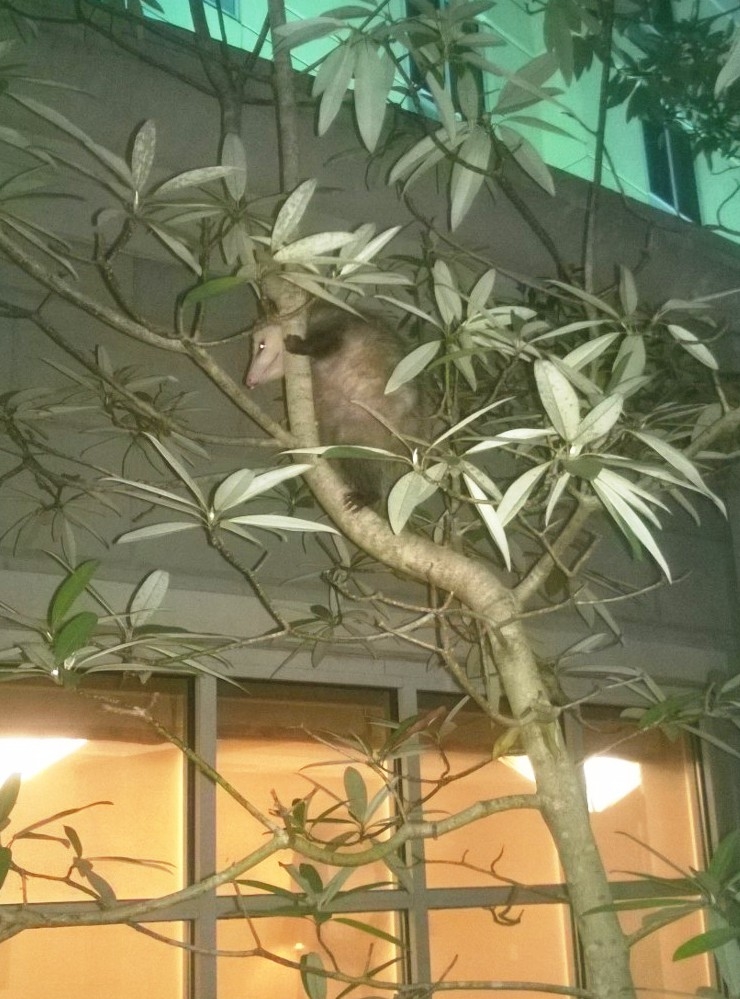
How To Know If There’s A Possum Living In Your Walls?
First, you may hear all kinds of odd noises in your walls, especially during the nighttime. One reason they make noise is they need to search for food. As possums are nocturnal animals, you may hear scraping and shuffling sounds as the animal is moving around in your walls.
You can hear noises when they are nesting, and when a new litter of possums arrives. Excessive scratching noise can indicate a female possum is making a nest. Baby possums make squeaking sounds.
However, the level of activity and the level of noise can both increase if there are multiple adult opossums in the wall. Clicking, hissing, chattering, growling, grunting, and screeching are signs that you are dealing with more than one animal. When male possums want to mate with females, they often make clicking and shook-shook sounds.
Unusual noise is not the only way you can determine the presence of possums in your walls. The second sign of possums is the odor. There are actually a number of different sources. While a possum has its own natural musky odor, the odor from its feces and urine is horrible.
In addition, opossums give off an odor when they are afraid, or fighting. Any strange odor coming from your walls should be investigated.
The third sign of possums is possum poop. The odor is similar to ammonia gas. The feces look similar to dog feces. It is approximately the same size and is usually dark brown. Opossum feces can carry a strain of bacteria that is very dangerous to people.
Fourth, you may see visible signs that opossums are in your house. Perhaps you notice pet food, or your own food, has disappeared. Perhaps your garbage can has been rummaged through or knocked over. Possums generally do not care what they eat. As scavengers, they are as happy with leftovers you put in the trash can as stealing food from your pet’s bowl or a sandwich you did not finish.
There can be other visible signs to the house itself. You may see damage to your home’s exterior or interior. Claw marks, and marks from scraping, scratching, and chewing are clear signs an animal is living in your house, and that animal could be an opossum.
If you suspect a possum is in your house, it is time to investigate. And if you know these animals are present, it is time to get rid of them.
Opossum removal from walls is essential to prevent costly damage to your home. However, larger animals, such as opossums, can prove tricky to exclude. They need to be captured using safe and humane live cage traps.
We are committed to solving your possum problem in the most efficient way possible. So get in touch with the experts at Westchester Wildlife for a free quote or just for some free phone consultation.
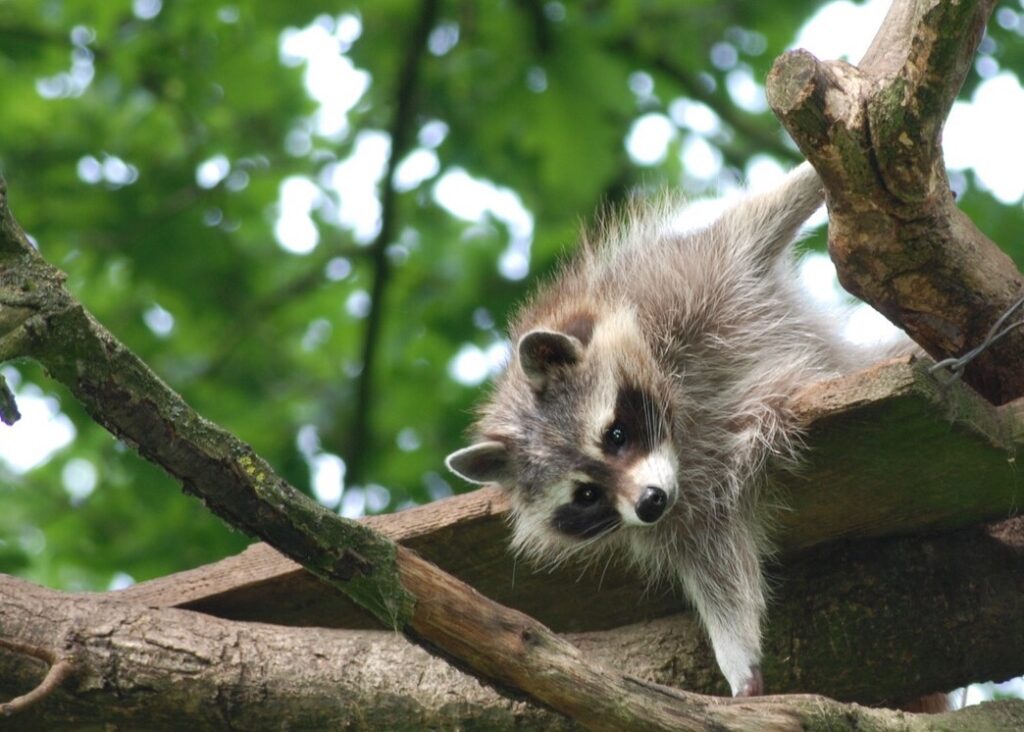 Are Raccoons Considered Good Jumpers?
Are Raccoons Considered Good Jumpers?
Raccoons are resourceful and persistent animals. They can invade your yard and garden, and destroy the crops you have worked hard for. These animals are considered skilled jumpers, climbers, swimmers, and runners. That’s why catching them can be a bit tricky for home owners.
It’s not uncommon to see a raccoon in your attic, fence, tree, or rooftop. While they aren’t built for jumping, they can reach a height of 4 feet. Now, you may not think of this as a big deal. But, considering that nothing about their shapes suggests that they can jump at all, this is quite remarkable.
Note that raccoons aren’t built for leaping or jumping. That’s because their body is heavy, and they don’t have super strong leg muscles. But they can still jump as high as feline animals do. Experts say that it’s easy for these animals to jump down from heights and horizontally. However, they can still scale to the top of most houses and fences.
How High Can Raccoons Jump Up Vertically?
Well, jumping upwards is not their thing. So when it comes to vertical jumping, raccoons usually don’t jump that high. Bear in mind that raccoons have stubbly little legs and are thick naturally. Combining these factors doesn’t allow them to jump a very high distance vertically. The highest they can go is 4 feet.
The bodies of raccoons are not designed for jumping. However, these animals adapt to their surroundings to survive. Therefore, if you see one on your rooftop, it probably didn’t jump straight up. High chances are that the animal leaped over something to get to the top. Generally, raccoons are said to be better at jumping off things instead of over them.
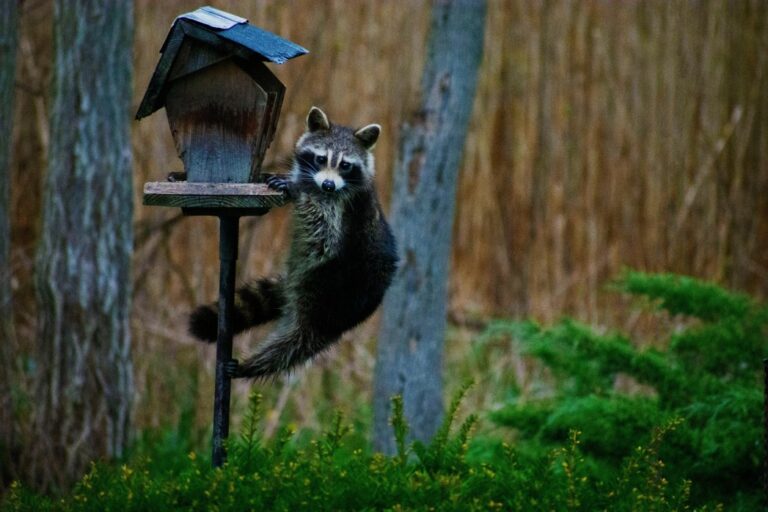
However, note that while their vertical jump is limited to 4 feet high, it doesn’t mean that they cannot jump to places as high as 40 feet and land safely without any injuries. This ability is mostly due to the fact the raccoons have stubby limbs. Their shorter forelimbs and longer hind limbs give them an arched shape when running.
Also, note that they are sluggish animals. Most of the time, these animals will gain weight when the summer is approaching. As such, it prevents them from jumping high.
Now, you might wonder why squirrels also have shorter limbs but jump higher compared to raccoons. That’s because naturally, raccoons do not have many predators. Therefore, they don’t have a good reason for jumping fast or high.
The same thing also applies when it comes to hunting prey. These animals rarely run after prey. Rather, they hunt for them while then they’re in their nest as they know they can’t abandon the nest.
How Far Can Raccoons Jump Horizontally?
This is where raccoons excel. Thanks to their elongated hind legs that allow them to extend their body length and leap forward quite quickly, these animals can jump to far distances.
Raccoons can jump up to 5 feet far when jumping from the ground and up to 10 feet when jumping from a height. That’s why they can easily move from one tree to another or one building to the next.
But note that they can’t go beyond that distance because of their paws. If they do, they risk being injured.
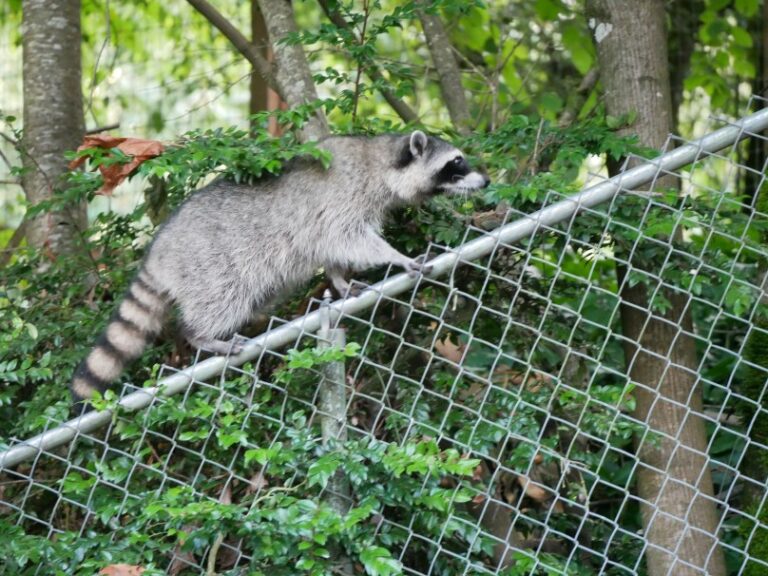
Can A Raccoon Jump Down?
Yes, a raccoon can jump from a great height downwards. They can even fall off on people or animals and hit or bite them. The impressive thing about their jumping or falling off a height is that they are not injured in the process.
That’s because their fur, although not that dense, offers some protection from injury. However, this doesn’t mean that they can’t be injured when they jump or fall from heights.
Raccoons can get injuries if they fall or jump off on hard surfaces or a wrong attempt. Again, remember that raccoons are generally heavier compared to cats. They weigh approximately 13-20 pounds. Heavier animals are more likely to get injured when they jump from a height than lighter animals. Therefore, raccoons can fall badly when compared to cats.
But, note that these animals are very intelligent. Plus, they are also good landers. Thus, when they jump or fall off from great heights, they know how to position their feet for a safe landing. Just like cats, they extend their legs when falling and turn in front of their feet but remain in the air.
In simpler terms, a raccoon will frontflip or backflip to turn to their front legs so that they land on their feet. They do this by first twisting the front legs. Then, they extend the front legs to a maximum length and then close to the ground.
When landing, these animals land on their paws first, then their legs. This reduces the risks of getting injured and makes the landing safe. Also, they use this trick to prevent them from falling on their back.
If you think you have signs of raccoons on your property, call us for a free phone consultation or an appointment.
Westchester Wildlife provides humane and effective trapping and removal services for raccoons from your home or business in Fairfield County CT, or Westchester, Putnam, and Dutchess Counties NY. We are a trusted wildlife removal company dedicated to helping you with all your wildlife infestation problems, no matter how big or small.
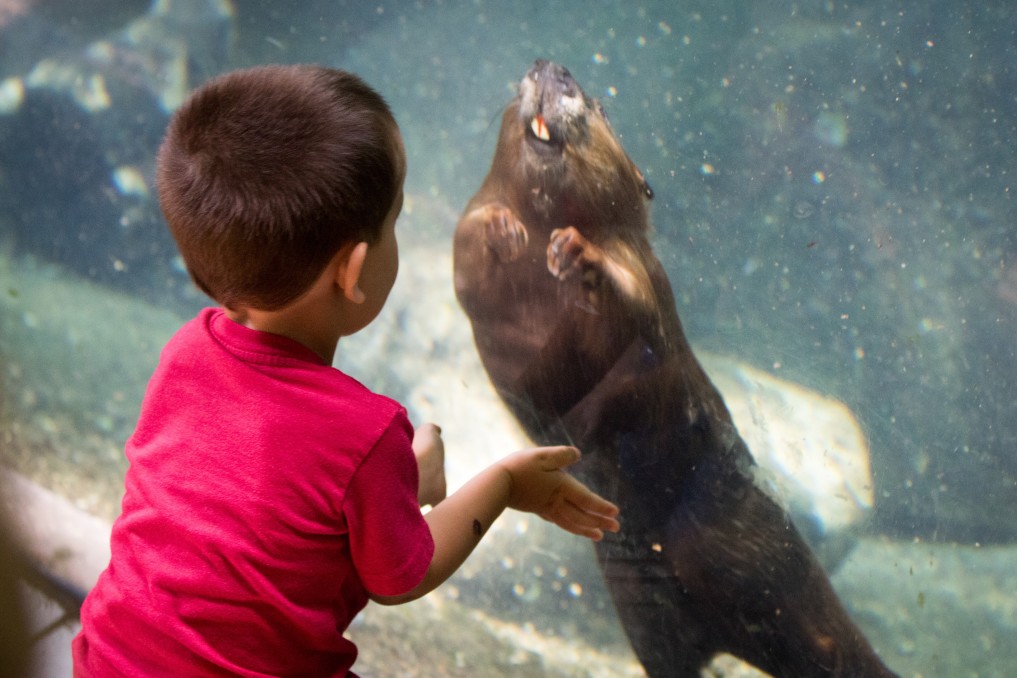 Are Beavers Friendly To Humans?
Are Beavers Friendly To Humans?
No matter if you live in the suburbs, in a rural area, or decide to go hiking or camping, you may encounter a beaver. Whether you become frightened or think the animal is cute, you may wonder if beavers are timid, friendly to humans, or dangerous. In short, while beavers are rarely aggressive, they are not necessarily friendly, either.
Do Beavers Like Humans Or Are They Afraid?
Beavers are wild animals and they prefer to be left alone in their natural habitat. You should not expect a beaver to walk up to you, pose quietly as you take pictures, or show other signs of friendliness.
While you will not encounter friendly beavers, they may actually be afraid of you. If you happen to be too close to a beaver, do not be surprised if he scurries away. As beavers do not like to be around people, these rodents simply want to get back to a safer environment.
Are Beavers Dangerous To Humans?
In most cases, beavers are not dangerous to people. The best way to avoid unnecessary problems with beavers is to leave them alone. Whether beavers live near your home, or you see them when you are out and about, they will generally not bother you if you do not bother them.
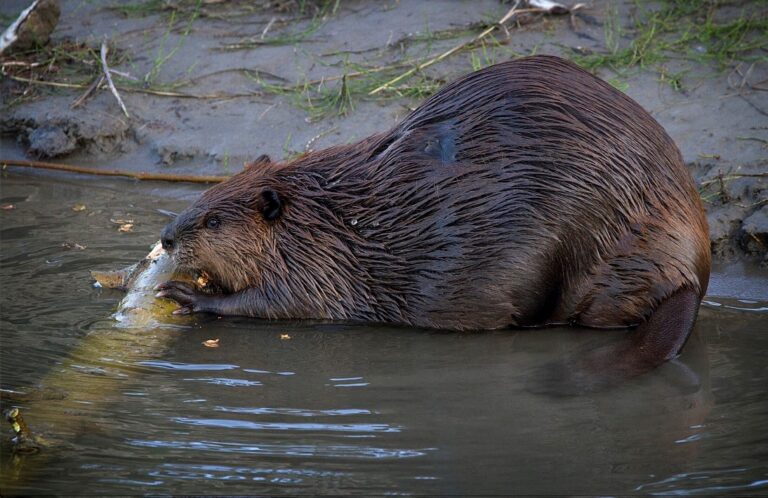
Are Beavers Gentle Or Aggressive Towards People?
In most instances, the answer to this question is “neither.” As beavers rarely approach humans, they are neither gentle nor aggressive. You can coexist peacefully with these animals if you keep a distance between them and yourself.
However, there are some circumstances in which beavers can become aggressive. One example is if a beaver feels threatened. If you are coming too close, and it perceives your behavior as threatening, it can react in an aggressive manner. This is why you should never corner a beaver.
A second example involves a beaver’s territorial nature. A beaver’s dam is not its home. It is a beaver’s protection against predators. There are numerous wild animals that prey on beavers, such as coyotes or foxes. The dam also ensures that beavers can access food in the wintertime.
As a dam has a purpose for beavers, it is only logical that they need to protect it. Dams are not meant for human enjoyment or entertainment. Never approach a dam out of curiosity or to take pictures, and never allow children to play near it. Otherwise, the beavers can become aggressive.
A third example is a beaver that has rabies. While rabies infections show symptoms, stay alert to behaviors that are not common in beavers. Any kind of agitated behavior is the reason for concern.
If you think a beaver may have rabies, do not get near the animal. Immediately call a wildlife control company in your area so that they can safely remove it from your property. Not only can rabies be deadly to a beaver, but it can be a life-threatening situation for you, too, if you are bitten. The same possibility applies to domestic animals. You should keep your pets away from beaver dams, and other areas where beavers are common.
Fourth, beavers can attack when they are afraid. As they are nocturnal animals, it can be as basic as disorientation during the daytime. A beaver can feel fear even when there is no other reason.
Can A Beaver Attack, Kill, Or Bite You?
Yes, beavers can bite, attack, and even kill people. Although it is not common, it is occurring more and more frequently. One reason there are more attacks is people fail to use logic. If you intrude into a beaver’s territory, do not expect a welcome response.
If you are bitten by a beaver, it can result in a dangerous infection or a serious injury. Although bites themselves are rarely fatal, at least one reported fatality has occurred. A bite severed a man’s artery, and the man bled to death. The smartest way to deal with beavers is to enjoy them from a distance.
However, a beaver will not usually attack without warning. If it is on land, it will stand on its hind legs. If it is in the water, it will slap its tail. Before it attacks a human or an animal, it will start hissing and growling. If a beaver shows any of these signs that it is preparing to attack, do not wait to see what happens. Take it as a warning to get out of the area as quickly as possible.
If you encounter a beaver on your property, get in touch with a wildlife professional who is experienced in trapping and removing wild animals. At Westchester Wildlife, we are your beaver control specialist! Contact us today if you require beaver control or removal services in Westchester, Dutchess, Putnam, or Fairfield counties.
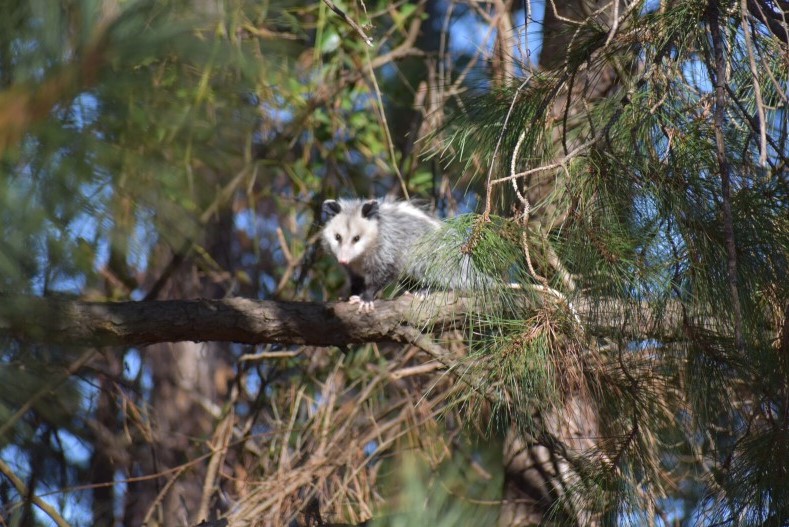 Do Opossums In Roof Cause Damage?
Do Opossums In Roof Cause Damage?
Any wildlife invading the roof, including opossums, can cause damage to the structure of your house. Opossums are known to invade man-made buildings for a variety of reasons, such as shelter and food. If you have discovered an opossum living in your roof, take the necessary precautions to get rid of the animal.
The primary cause of opossum damage is their need for finding shelter. Opossums that stay outside will look for a suitable place to shelter.
If the opossum gets in your house, they will look search for a location to live in your attic or crawlspace. The animal may gnaw on wires and support beams, causing damage to the building structure. Wires that are chewed can cause electrical fires or cause an animal to be electrocuted. Support beams are important in keeping the structure of your house intact. If chewed, severe damage or even collapse can occur.
Opossums are also known to cause damage through their need for food. These marsupials will look for openings in which they can enter homes to find food. They are omnivores and may go after insulation, carpet, vinyl flooring, and drywall for food. Opossums also feast on insects such as termites and carpenter ants, which they consume while scratching the foundation of your house.
If you find an opossum in your roof, try to make the animal leave on its own accord. Often, the animal is seeking shelter or looking for food; it may not explore your home for very long. Leave the animal a well-lit exit to use, such as an open door or window. If you want to remove the opossum from your home yourself, make sure to do it safely. The last thing you want is a fight between an opossum and a human.
Opossums are generally not harmful to people, with rare exceptions. They might become dangerous with their ability to transmit many diseases such as tuberculosis leptospirosis, spotted fever, coccidiosis, tularemia, and others, thus, posing a serious health threat to humans and pets.
If you do not want opossums in your roof or anywhere on your property, contact a wildlife removal specialist to help remove the animal.
How Do Opossums Get In Your Roof?
Opossums get on the roof by climbing the trees surrounding the house. Once they’re on top of a tree beside your house, they can jump onto your roof. They may also climb a house’s corner, stairs, drain spout, or porch railing.
Once at the top of your house, the opossum will find a way inside to eat their favorite foods – insects, fruits, pet food, and garbage. They’ll leave smelly droppings behind as well. You will start noticing some exterior damage around the place it is residing.
To prevent a possum from climbing and getting in your roof and attic, trim large trees and branches back at least 5 feet away from the house. Wrap tree trunks to prevent scratching by sharp claws as they climb. Trim any exposed tree roots to keep opossums from using them as a foothold. Keep your porch, stairs, and other “hard-toed” areas free of grease, oil, or sticky substances that they could get stuck to. Clear away brush piles and dense ground foliage so they will not be an easy spot for the opossum to hide.
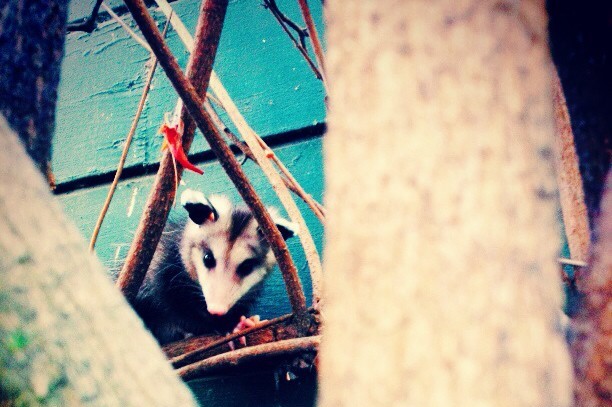
Can Opossums Live In Your Roof, And Why?
Opossums can live on your roof, and they surely will if you’re not careful. They can climb nearly any surface, but that doesn’t necessarily mean that they want to live on top of your house.
They’ll only go up there when forced out of their territory, and this typically happens during the mating season. Since they can’t get very far, they’ll usually start looking for a place to sleep, which is often your roof. They may even have a den already set up in one of your gable vents or soffits! Once they find a comfortable spot, safe from predators and without too much noise, their new home will be hard to evict.
What To Do When You Have Opossums In Your Roof?
Opossums are shy creatures, so you need to give them a safe route to get out without being exposed. The best way is to have a cover on the ground below the roof. If this isn’t possible, place boards or anything opossums can use as a bridge between your roof and another structure nearby. After the opossum has left the roof, clean the areas thoroughly with disinfectant to get rid of the bad odor.
Once you have got the possum out of your roof, make sure to check the area for entrance points. An opossum is known to be a great climber, so it may have left through a window, or other opening, that should be easily closed and sealed with caulk around the frame. It is important to close all access points to the attic, which the wildlife may use to get inside.
If an opossum is currently living in your roof, do not attempt to go up and get it out. They may bite and scratch and the risk of contracting a disease through their teeth or claws is high. Do not approach the animal and call a professional pest and wildlife control company for assistance. The experienced technicians will humanely trap it and remove it from your house.
If you have an opossum problem or any problem regarding wildlife that has invaded your home, contact our team of experts at Westchester Wildlife right away. We serve Westchester, Dutchess, Putnam, NY, and Fairfield County, CT.
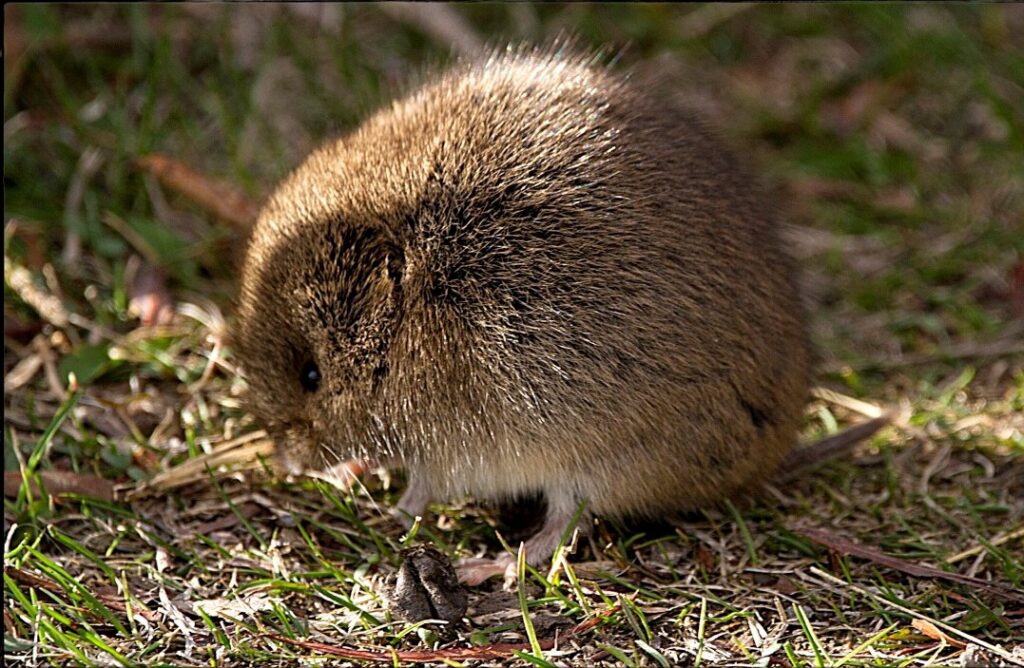 Do Voles Infest Houses Or Just Lawns?
Do Voles Infest Houses Or Just Lawns?
Voles are small mammals that look cute and harmless, but they are also known for causing damage due to their tendency to dig. They are often confused with either moles or mice, but they are neither of them. The meadow vole, also known as the meadow mouse, is a rodent closely related to a mouse but not quite the same.
These small animals are not aggressive but lead a very active life and are known for their great digging abilities. Although they do not infest houses often or on purpose, they can sometimes be found indoors. One or two of them may find their way into your house by accident.
Voles are not the kind of animals that sleep when it is dark, and therefore, they can be active whether it is day and at night. Being active all year round and their ability to dig makes voles very destructive whenever they invade your outdoor property. These rodents can do a lot of damage to your lawn and garden when they dig tunnels in the soil.
They enjoy eating plants and gnawing stems of plants, and they also like feasting on grass blades. That is why they can be very destructive to grass as well as crops. When voles come to your property, you will notice some previously healthy plants are damaged or dead because the voles have feasted on the roots.
Why Do Voles Go Into Houses And How Do They Get Inside?
Typically, voles are not indoor pests and are not interested in getting into your home. They spend most of their time outdoors, even when they end up in your home. Their greatest interest is the plants in your yard as they feed on them.
Voles are not very afraid of snow but may want to seek shelter by burrowing through it to get to a warmer place. During winter, the voles may let the snow cover them and protect them from their predators.
But sometimes they may want to seek some heat and thus dig a tunnel in the lawn searching for a warm space. These tunnels may lead them into the house without knowing, depending on where they begin their burrowing. For example, they may start digging from underneath your patio and find themselves ending into the warm space of your house. Their main intention may not be to get into your house, but the tunnels may lead to the house.
Voles are very skilled at digging, and if they infest your yard, you will immediately know when you find some holes that look like a series of raised tunnels on the surface of your lawn. The voles make these underground tunnels as they dig in the turf. They also wear down the grass with their feces as they move along their runways that they have created in the lawn.
These animals are poor climbers and do not like to infest buildings, but they sometimes find themselves in the house without planning. The digging behavior of voles leads them to make burrows, especially when they feel that it has become colder outside. But all they want is to get into a warmer place, not realizing that sometimes the tunnels may lead into a house.
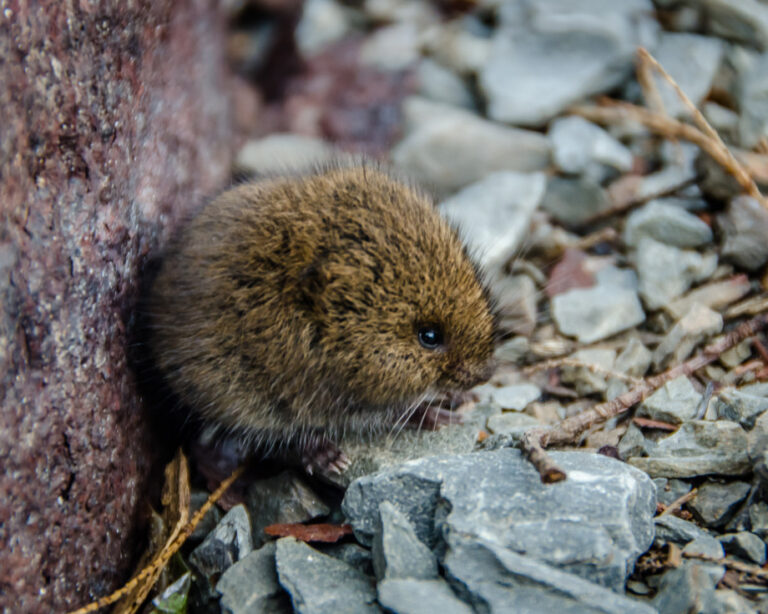
Can Voles Damage Houses And What Damage Can They Do To Your Property?
When voles get into your outdoor property, most of which they will do as they seek watered lawns during the dry season, they can damage your lawn and trees in your yard.
These small animals like running around in the tunnels they create in your landscape. They will do that by feeding on your lawn and any garden plants in your yard. You will notice extensive vole damage around your home’s foundation plantings. The animals can also gnaw through all the way around the base of young trees and other woody vegetation.
This can be very frustrating because they like concentrating more on the roots of the plants and this is what causes most of the plants to die. In addition, voles live in colonies, and as the colonies keep growing, they eventually increase the number of tunnels and spread them all over the lawn.
However, that does not mean that you should let them stay in your house if they happen to get inside, just because they don’t do much with your property. When they get into your house, they might bring parasites like ticks, mites, and fleas that are harmful to you and your pets. Also, their feces and urine are not safe and can spread some serious diseases. Therefore, as much as voles may not bite you, you should not tolerate them and live with them in the house.
Voles are known to dig through the fence into your garden. To protect your vegetation from a vole infestation, you can install a special vole-proof, woven wire or hardware cloth fence around small gardens and flower beds to keep those rodents away.
You can also use vole repellant products to spray in your yard, but your best bet is to call professional exterminators once you find these animals have entered before using any home remedies.
Our vole removal experts at Westchester Wildlife know best how to deal with the rodents and how to eliminate them from your property. So protect your home, call us today for more information and to make an appointment.
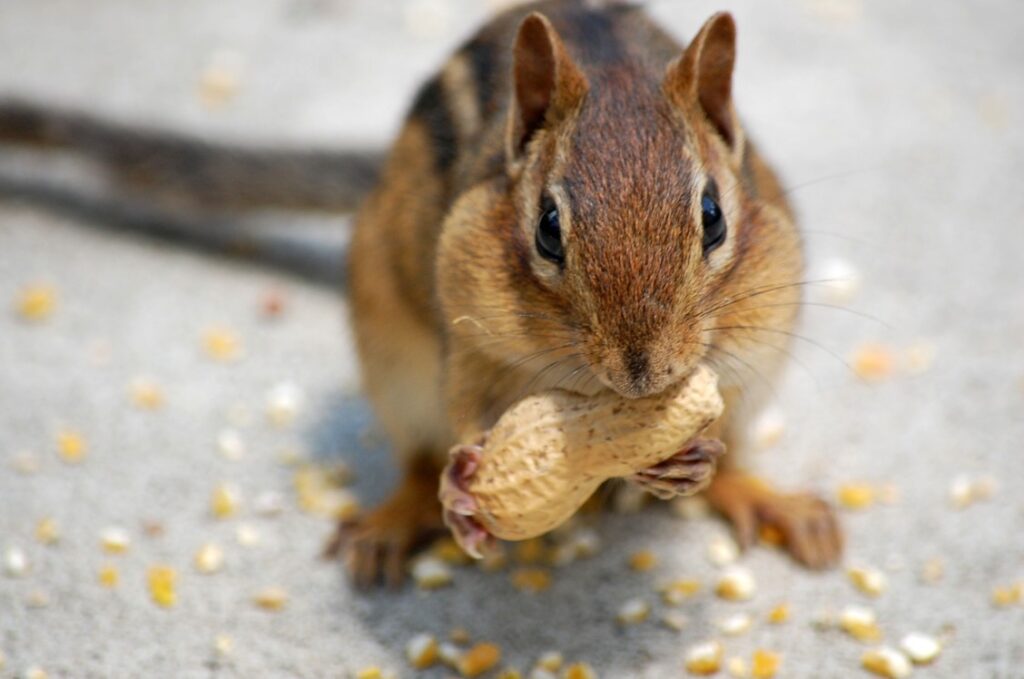 Are Chipmunks Smarter Than Squirrels?
Are Chipmunks Smarter Than Squirrels?
Animals tend to have intelligent capabilities that are far advanced beyond what we think about them. Animals have improved their habits based on the influence of the environment, and most of the things they do indicate that they are bright and intelligent.
When we compare a chipmunk and a squirrel, we find the chipmunk to be smarter than a squirrel. This might come as a surprise, but it is a fact observed from their nature. Both animals are smart and intelligent, but the chipmunk is a bit smarter than the squirrel. Let us break it down.
How Intelligent Is A Chipmunk And A Squirrel?
Chipmunks are known to make homes for themselves by creating complex tunnel systems in their burrows. They can create a system up to 30 feet long, which is evidence of their great IQ. They can also make nests in bushes and logs and only interact during the mating season. They also have a complicated communication system that uses various calls, which all have different meanings.
Squirrels are always obsessed with nuts. They can always be seen burying them and seem always to remember precisely where they had buried their stash. Instead of storing all their nuts in one place to prepare for the winter, the squirrels are scatter-hoarders and will keep nuts in several places.
This shows that they are organized creatures that are always meticulous about how they store their food. They also have a strong sense of smell which helps them find food.
However, in terms of IQ, the chipmunks exceed the squirrels since they have been known to create more complex systems for their habitat.
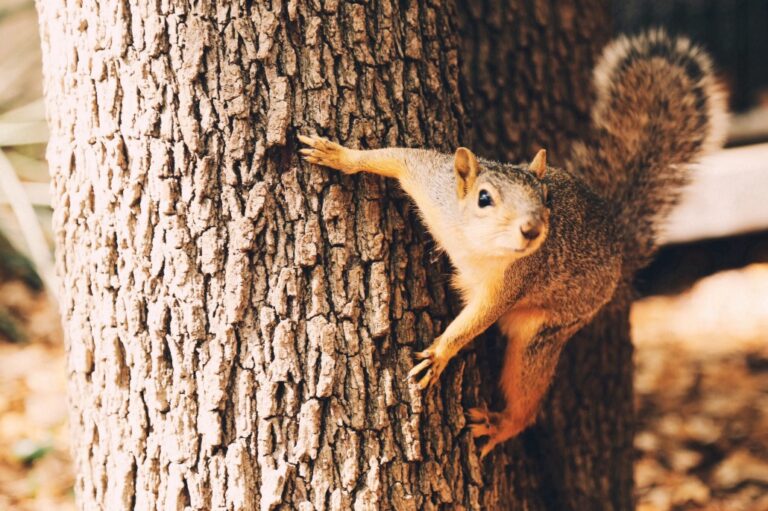
How Do Chipmunks And Squirrels Communicate?
Chipmunks have vocal communication, which is primarily made up of a series of high-pitched “chip” noises that are similar to the chirping of birds. The repeated sounds can last for up to 30 minutes and make claims on their territories. If these calls are challenged, it can sometimes lead to aggression. The vocalizations are also quite complex and are all used to pass different information to the other chipmunks within hearing distance.
To respond to a danger on the ground, such as when a chipmunk is being chased by a predator, it will use deep clucking sounds or trills that are much shorter than chips. They are a warning to other chipmunks to be more alert and vigilant.
In addition, body language is used when one chipmunk comes across other chipmunks. These are visual cues implying their intention and can be accompanied by chemical communication through smells.
Squirrels make use of a vast number of complex signals to communicate with each other. These include complex vocalizations, scent, and visual cues. Vocalizations can be categorized into warnings, mating, nesting, and aggressive calls. A male pursuing a female squirrel will use a series of calls similar to sneezes to get her attention. A frightened squirrel will let out a small shrill scream.
Squirrels also use the tail for communication, and it can be shaken or waved depending on the message. Moreover, body language is used by the squirrels to convey their emotional state. Scents are also part of their communication, and they use them to mark their territory.
Can Chipmunks And Squirrels Understand, Remember, Or Recognize Humans?
Squirrels have, over time, adapted to living with people and have been proven to have an excellent memory. They can remember humans and can recognize the people that can be trusted as a source of food. Their memory is evident in studies where they were able to navigate a maze.
Chipmunks are not social and friendly. They would not even make a good pet and always try to stay hidden. Only chipmunks raised from an early age will be accustomed to human contact, and they can learn to play and tolerate petting.
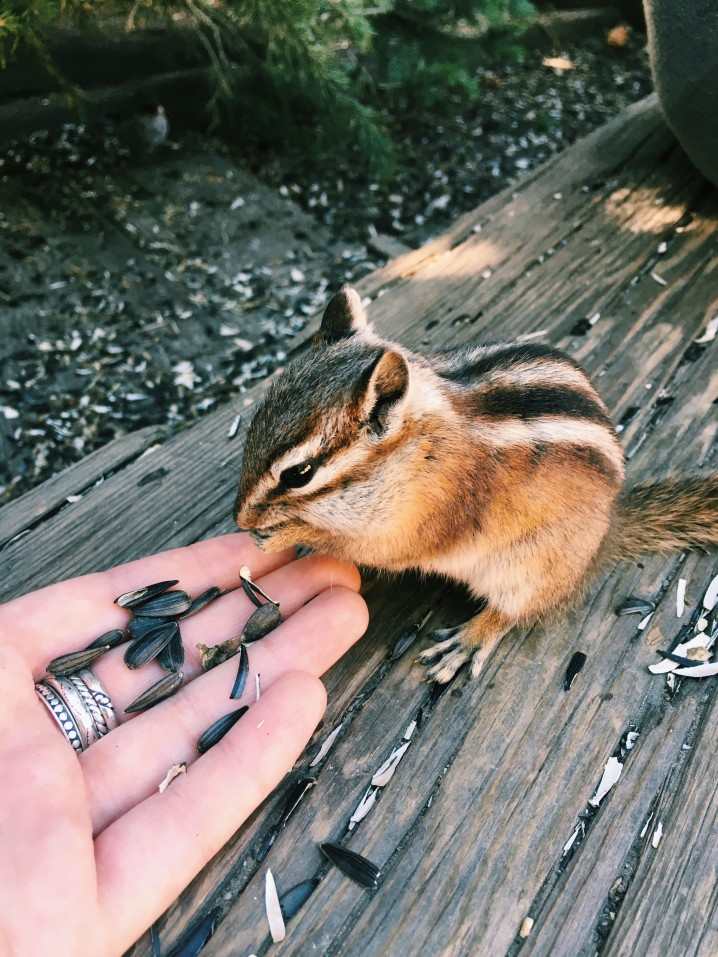
Do Chipmunks And Squirrels Bite?
By nature, squirrels are not known to be aggressive, they are usually frightened of humans and will not attack them. Their natural defense is to bite whenever they feel threatened, but they will not bite their owners hard. The biting habit is a natural trait of the squirrels, and they cannot stop it. A pet squirrel will only bite playfully, and it will not hurt you.
Chipmunks are harmless unless they are feeling threatened. In such a scenario, the chipmunk will bite you hard and run off as fast as it can. When stressed, chipmunks become a lot more aggressive, and in this case, they will scratch or bite you.
When you see a distressed chipmunk, be sure to keep your hands away from it as it has very sharp teeth, and the bite will hurt. If it bites deeply, you might even start to bleed, and you must be treated immediately to avoid the risk of infection or even a septic reaction.
Treating the wound as soon as possible is the recommended course of action when a chipmunk has bitten you. Although they do not carry rabies, chipmunks can transmit other diseases such as Lyme disease, plague, and La Crosse encephalitis.
Our Westchester Wildlife technicians are highly trained and experienced in eliminating squirrels and chipmunks from your property. If you’re seeking squirrel or chipmunk control services in Westchester, Dutchess, Putnam Counties, NY, and Fairfield County, CT, contact us today to schedule a free phone consultation or an appointment with our qualified team of pest and wildlife exterminators.
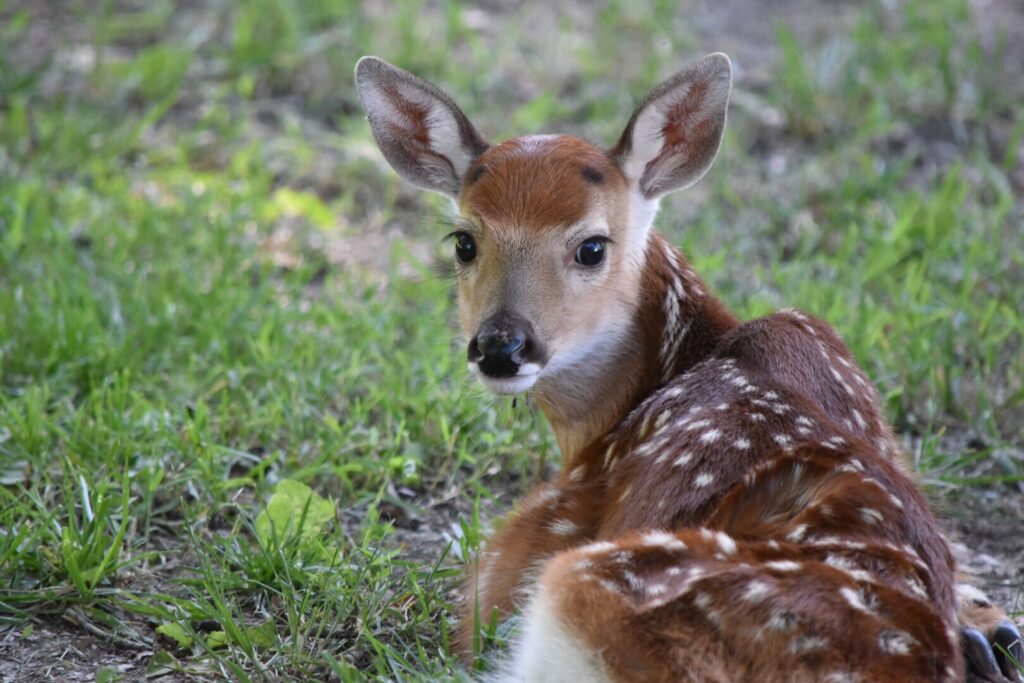 Why Do Deer Sleep In My Yard?
Why Do Deer Sleep In My Yard?
As deer are hoofed animals, they are the poorest sleepers of all species of wildlife. One of the reasons is that they are easy prey for predators. Another reason is that their bodies, unlike those of smaller prey, are too large to take refuge in protective burrows.
Deer and other wild ungulates spend all their time either awake or barely asleep. This is due to the threat that being deep in sleep can lead to a situation in which they are vulnerable to attack. Their alertness and speed are the only defense against predators.
When you notice a deer sleeping in your yard and try to approach it, it may be startled by your presence in their sleeping area. So if you spot a deer or several deer leap away, don’t get nervous. Try to remain calm and carefully step back in the direction from which you originally came from. You wouldn’t want to scare the deer into moving to another place on your property!
Read on to learn more as we talk about deer sleep habits.
Where Do Deer Normally Sleep And Rest?
On average, deer will sleep anywhere as long as they feel very safe and the place has a good supply of food resources.
Areas with thicker plant growth are selected most often as their bedding (sleeping) areas. Deer usually sleep hidden in the underbrush.
Also, as their bedding site, deer choose a flattened place that has a shape similar to their body.
Deer often bed in standing corn and graze on the clover. They can sometimes be seen venturing into food plots during the day, but even though they’re resting, they are extremely wary.
What’s more, ponds attract all kinds of wildlife, including deer. So if you have a small pond in your backyard, deer may stay close to the water source. In particularly cold or dry weather, deer need to drink more often, thus, they will visit your pond to get water. They also like the vegetation that grows around the pond. This provides them with a cover and shelter to rest and sleep.
Do Deer Sleep In The Same Place Every Night?
Deer do not sleep in a single location all year round. Most of them have a limited number of potential bedding sites within their home range. These locations are most likely determined by the degree of shading, slope and aspect of the ground, wind speed and direction, and proximity to sources of food.
By having several sleeping sites in a home range, these animals might change which ones they use whenever they change their feeding location. Female deer are particularly prone to using specific bedding sites during the fawning season.
Where Do Deer Sleep When It Rains?
Deer can sense when a storm or rain is coming, which allows them to find a suitable location in advance, where they can rest until the rain is over. These animals will rest and sleep in the same way as any other wild animals do during rain.
However, depending on the intensity of the rainfall, their habits may differ slightly. They usually feel safer making movements when the rain is steady, with very little or no wind. The moisture and raindrops on the vegetation allow them to move through the forest without making any noise.
Deer are able to adapt in the rain and are not much affected by the rain due to certain characteristics. The rain stimulates their senses and confidence, for example, they have a stronger sense of smell in the rain. Their thick fur keeps them warm, even in harsh and very cold weather conditions.
Additionally, deer bedding sites can be found in locations with a thermal cover. These areas are sheltered from the rain and wind, usually in thick shrubs, stands of conifer trees and other very tall trees.
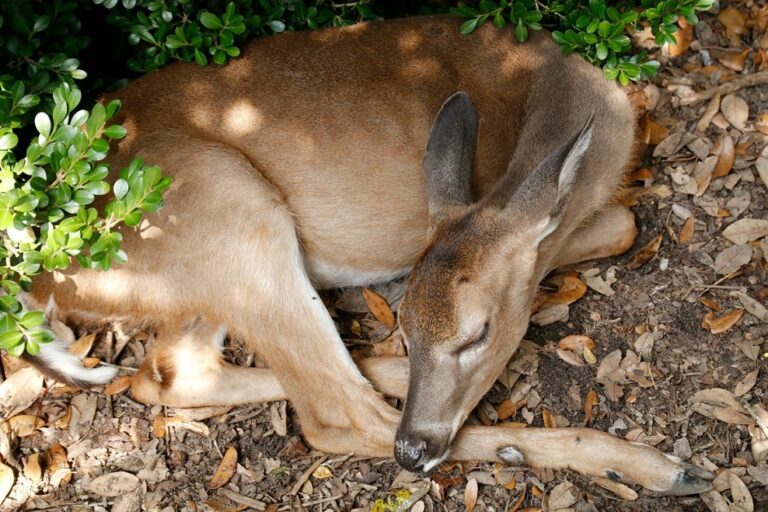
Do Deer Lay Down To Sleep?
Deer usually lie down when they want to sleep. This is because they lose muscle control while sleeping and are not able to lock their legs to remain standing, the same way that elephants do. This usually makes the sleeping down on the ground serve a dual function – as a place to sleep or rest, and to ruminate their food.
While the deer is lying down during sleep, it typically folds its legs upwards beside its body. Its head is left raised so that the deer is able to smell and hear as much as possible. In this position, the deer will chew their food, groom themselves, rest, and sleep.
How Long Do Deer Sleep Per Day?
Deer do not spend a lot of time sleeping. This wildlife sleep in stretches of only a few minutes at a time.
Young deer play all day and sleep the night through. Adult deer try to snooze during the day as well and do their deer duties like foraging for food and feeding mainly at night.
Because deer fall prey to many carnivores, they are usually alert, especially when bedded down. Studies have shown that deer sleep an average of around 4.5 hours a day and only 30 minutes in a deep sleep state (REM). Some researchers confirm that the best description of how deer sleep is drowsiness, which means that they are neither completely awake nor fully asleep.
Deer do not restrict their sleeping periods to nighttime, but alternate bedding with feeding and ruminating (i.e. chewing their food) throughout the 24-hour cycle.
Do Deer Sleep Together?
Deer are social animals that travel, rest, and sleep together as a family. Does (female deer) stay and sleep with their offspring. Sometimes a doe that has no fawns might be spotted alone, and also bucks (male deer) can often go their separate ways, especially during the rut. But overall, it is far more common to see deer in groups, especially does which typically travel in family groups.
During the cold season, particularly in winter, does often form into larger bands with their offspring, and sometimes even the offspring of the offspring for a multi-generation family group, where they sleep together to keep them warm. Bucks, on the other hand, stick in bachelor groups for the most part of the year.
During the winter and times of deep snow cover, multiple deer will bed together. They create mass bedding sites where there is sufficient protection from the elements.
The highly skilled and experienced technicians at Westchester Wildlife can get rid of deer on your property using safe, quick, and effective methods of trapping and removal. So if you have a deer problem, contact our wildlife specialists today for a free quote!
 Are Deer A Nuisance To Your Yard?
Are Deer A Nuisance To Your Yard?






















